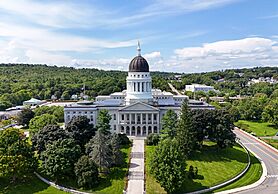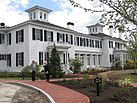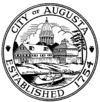Augusta, Maine facts for kids
Quick facts for kids
Augusta
|
|||||
|---|---|---|---|---|---|
|
Water Street, downtown
|
|||||
|
|||||
| Motto(s):
A Capital Opportunity
|
|||||
| Country | United States | ||||
| Region | New England | ||||
| State | Maine | ||||
| County | Kennebec | ||||
| Settled | 1754 | ||||
| Incorporated (town) | February 20, 1797 | ||||
| Incorporated (city) | August 20, 1849 | ||||
| Village | North Augusta | ||||
| Area | |||||
| • Total | 58.04 sq mi (150.31 km2) | ||||
| • Land | 55.15 sq mi (142.83 km2) | ||||
| • Water | 2.89 sq mi (7.48 km2) 5.00% | ||||
| Elevation | 121 ft (37 m) | ||||
| Population
(2020)
|
|||||
| • Total | 18,899 | ||||
| • Density | 342.70/sq mi (132.32/km2) | ||||
| Time zone | UTC−5 (Eastern) | ||||
| • Summer (DST) | UTC−4 (Eastern) | ||||
| ZIP Codes |
04330, 04332-04333, 04336, 04338
|
||||
| Area code(s) | 207 | ||||
| FIPS code | 23-02100 | ||||
| GNIS feature ID | 581636 | ||||
| Website | AugustaMaine.gov | ||||
Augusta (/əˈɡʌstə/ ə-GUSS-tə) is the capital city of Maine, a state in the United States. It is also the main city in Kennebec County. In 2020, about 18,899 people lived here. This makes Augusta the 12th largest city in Maine. It is also the third smallest state capital in the U.S.
English explorers first visited this area in 1607. Before Europeans arrived, Algonquian-speaking Native Americans lived here. In 1625, settlers from Plymouth Colony set up a trading post. It was called "Cushnoc" and was built around 1628. Later, in 1754, Fort Western was built nearby. The new village became a town called Hallowell in 1771. In 1797, the northern part of Hallowell became a new town called Harrington. Soon after, Harrington changed its name to Augusta. In 1827, Augusta was chosen to be the capital of Maine.
Augusta is the easternmost state capital in the United States. It sits on the Kennebec River. The city is home to the University of Maine at Augusta. Because of its location, downtown Augusta can sometimes flood in the spring. A big flood in 1987, called the "Great Flood," affected the city. A stream called Bond Brook runs through the city center. It is known for its wild Atlantic Salmon.
The city has different neighborhoods. The "west side" is a historic area near the state capitol. The "east side" is across the Kennebec River. The northwest part of the city has both shops and homes.
Augusta has its own airport, Augusta State Airport. It offers both commercial flights and flights for smaller planes. Major roads like Interstate 95, U.S. 202, and U.S. 201 pass through or near the city.
Contents
History of Augusta
Early Settlements and Trading
English explorers first came to this area in September 1607. Twenty-one years later, in 1628, English settlers from the Plymouth Colony created a trading post. This post was on the Kennebec River. The Native Americans called the settlement Cushnoc, which means "head of the tide."
At first, Fur trading was very successful. But due to Native American uprisings and less profit, Plymouth Colony sold the land in 1661. Cushnoc was then empty for about 75 years.
Native American Relations
The area around Cushnoc was home to the Kennebec people. They were a group within the larger Abenaki nation. In the 1600s, they were friendly with the English settlers.
However, a place called Norridgewock, further up the Kennebec, was a center of Abenaki resistance against British settlements. In 1722, the tribe attacked Fort Richmond and destroyed Brunswick. In response, English forces attacked Norridgewock in 1724 during Dummer's War. This gave the English more control over the Kennebec River area.
Fort Western and the American Revolution
During the French and Indian War in 1754, English colonists built a blockhouse called Fort Western. It was built at Cushnoc on the east side of the Kennebec River. This fort was a supply base for Fort Halifax and helped protect against French attacks.
Later, during the American Revolutionary War, Benedict Arnold and his 1,100 soldiers used Fort Western. It was a starting point for their journey up the Kennebec River. They were heading to the Battle of Quebec.

Becoming Maine's Capital
Cushnoc became part of Hallowell in 1771. In February 1797, it became its own town called Harrington. But in August of that year, its name was changed to Augusta. This new name honored Pamela Augusta Dearborn, the daughter of Henry Dearborn. In 1799, Augusta became the county seat for the new Kennebec County.
Maine became a state in 1820. In 1827, Augusta was chosen as its capital. This was a big decision, as other cities like Portland also wanted to be the capital. The Maine State Legislature met in Portland until the Maine State House was finished in 1832. This important building was designed by Charles Bulfinch. Augusta officially became a city in 1849.
Growth and Industry
After becoming the state capital, Augusta grew quickly. Good soil helped with farming. Water power from streams helped new industries. In 1837, a dam was built across the Kennebec River. By 1838, ten sawmills were working. When the Kennebec & Portland Railroad arrived in 1851, Augusta became an even busier mill town.
In 1883, the Edwards Manufacturing Company bought a large property. They built big brick mills to make cotton fabrics. They brought cotton from the South to process and then sent it to Europe. Later, a paper and pulp factory was built. Other businesses in Augusta made lumber, windows, shoes, and furniture. The city also became a center for publishing and shipping. Today, government work and colleges are important to Augusta's economy.
Military Presence
Augusta has had a military presence since the mid-1700s. Fort Western stopped housing troops in the 1790s. But in 1828, the U.S. Government built an arsenal to protect its interests. During the Civil War, Augusta was a meeting point for Union soldiers. Many soldiers camped in front of the capitol building. In 1862, Camp E.D. Keyes was set up in the city.
During World War I, Camp Keyes was used to train soldiers. It later became the headquarters for the Maine National Guard. In 1929, the Augusta State Airport was built next to the camp. As the airport grew, the camp was no longer used for training. Today, it is still used for administrative and logistical work by the National Guard.
Modern Developments
In the 1800s, Augusta got regular steamboat service and a railroad. Gas lights were installed in 1859. Telephone service became available in 1880, and a local hospital opened in 1898. In the early 1900s, Augusta built two movie theaters and a film production studio.
Downtown Augusta Today
For most of Augusta's history, the main business area was on Water Street. This street was the center of trade and industry. Many fires damaged this area, including one in 1865 that destroyed almost 100 buildings. In 1890, the first trolley line started operating on Water Street. It connected Augusta with Gardiner and Hallowell.
In 1932, buses replaced the trolley line. When the Maine Turnpike and Interstate 95 were finished in 1955, businesses started moving away from Water Street. They moved closer to the highway. This led to many empty storefronts downtown.
Since the late 2000s, city officials and local groups have been working to make the downtown area lively again. They are focusing on bringing new life and businesses back to the heart of Augusta.
Augusta's Geography
Augusta is located at 44°18′38″N 69°46′46″W / 44.31056°N 69.77944°W. It is the easternmost state capital in the United States. The city covers about 58 square miles (150 square kilometers). Most of this area is land, with about 2.9 square miles (7.5 square kilometers) of water. Bond's Brook, Woromontogus Stream, and the Kennebec River all flow through Augusta.
Major Roads
Several important roads cross through Augusta. These include Interstate 95, U.S. Route 201, U.S. Route 202, and several state routes like Route 3 and Route 27.
Neighboring Towns
Augusta shares borders with several towns. To its west is Manchester. To the north are Sidney and Vassalboro. Windsor is to the east, and Chelsea is to the south. The city of Hallowell is to Augusta's southwest.
Climate in Augusta
Augusta has a humid continental climate. This means summers are usually warm, rainy, and humid. Winters are cold, windy, and snowy. Spring and fall are generally mild, but the weather can change a lot.
The hottest month is July, with an average high temperature of 80°F (27°C). January is the coldest month, with an average low of 10°F (-12°C). Most snow falls from December to March. It rarely snows in April and November, and it's very rare in May and October.
| Climate data for Augusta, Maine (Augusta State Airport), 1991–2020 normals, extremes 1948–present | |||||||||||||
|---|---|---|---|---|---|---|---|---|---|---|---|---|---|
| Month | Jan | Feb | Mar | Apr | May | Jun | Jul | Aug | Sep | Oct | Nov | Dec | Year |
| Record high °F (°C) | 61 (16) |
64 (18) |
85 (29) |
90 (32) |
94 (34) |
98 (37) |
99 (37) |
100 (38) |
96 (36) |
85 (29) |
76 (24) |
67 (19) |
100 (38) |
| Mean maximum °F (°C) | 49.7 (9.8) |
48.7 (9.3) |
59.4 (15.2) |
74.5 (23.6) |
85.5 (29.7) |
89.4 (31.9) |
90.7 (32.6) |
89.9 (32.2) |
86.0 (30.0) |
74.6 (23.7) |
63.7 (17.6) |
53.5 (11.9) |
93.1 (33.9) |
| Mean daily maximum °F (°C) | 28.8 (−1.8) |
31.9 (−0.1) |
40.6 (4.8) |
53.5 (11.9) |
65.8 (18.8) |
74.4 (23.6) |
79.9 (26.6) |
78.9 (26.1) |
70.9 (21.6) |
57.9 (14.4) |
45.7 (7.6) |
34.7 (1.5) |
55.2 (12.9) |
| Daily mean °F (°C) | 20.4 (−6.4) |
23.2 (−4.9) |
32.0 (0.0) |
43.8 (6.6) |
55.3 (12.9) |
64.2 (17.9) |
70.1 (21.2) |
68.9 (20.5) |
61.0 (16.1) |
49.2 (9.6) |
38.0 (3.3) |
27.2 (−2.7) |
46.1 (7.8) |
| Mean daily minimum °F (°C) | 12.1 (−11.1) |
14.4 (−9.8) |
23.4 (−4.8) |
34.2 (1.2) |
44.7 (7.1) |
54.1 (12.3) |
60.3 (15.7) |
58.8 (14.9) |
51.0 (10.6) |
40.4 (4.7) |
30.3 (−0.9) |
19.8 (−6.8) |
37.0 (2.8) |
| Mean minimum °F (°C) | −7.6 (−22.0) |
−4.1 (−20.1) |
4.0 (−15.6) |
23.8 (−4.6) |
34.4 (1.3) |
44.2 (6.8) |
52.5 (11.4) |
49.6 (9.8) |
37.8 (3.2) |
28.4 (−2.0) |
16.2 (−8.8) |
1.3 (−17.1) |
−9.7 (−23.2) |
| Record low °F (°C) | −22 (−30) |
−23 (−31) |
−11 (−24) |
9 (−13) |
26 (−3) |
36 (2) |
43 (6) |
39 (4) |
28 (−2) |
21 (−6) |
4 (−16) |
−15 (−26) |
−23 (−31) |
| Average precipitation inches (mm) | 2.62 (67) |
2.32 (59) |
3.21 (82) |
3.82 (97) |
3.27 (83) |
4.01 (102) |
3.20 (81) |
3.41 (87) |
3.90 (99) |
4.69 (119) |
3.95 (100) |
3.44 (87) |
41.84 (1,063) |
| Average snowfall inches (cm) | 19.0 (48) |
14.8 (38) |
15.2 (39) |
4.5 (11) |
0.0 (0.0) |
0.0 (0.0) |
0.0 (0.0) |
0.0 (0.0) |
0.0 (0.0) |
0.3 (0.76) |
3.6 (9.1) |
13.9 (35) |
71.3 (181) |
| Average precipitation days (≥ 0.01 in) | 10.1 | 9.5 | 11.0 | 11.9 | 13.1 | 12.7 | 12.2 | 10.7 | 10.2 | 12.3 | 11.3 | 12.3 | 137.3 |
| Average snowy days (≥ 0.1 in) | 8.7 | 6.9 | 6.1 | 1.9 | 0.0 | 0.0 | 0.0 | 0.0 | 0.0 | 0.3 | 2.8 | 6.9 | 33.6 |
| Source: NOAA (snow 1981–2010) | |||||||||||||
People of Augusta
| Historical population | |||
|---|---|---|---|
| Census | Pop. | %± | |
| 1800 | 1,211 | — | |
| 1810 | 1,805 | 49.1% | |
| 1820 | 2,457 | 36.1% | |
| 1830 | 3,980 | 62.0% | |
| 1840 | 5,314 | 33.5% | |
| 1850 | 8,225 | 54.8% | |
| 1860 | 7,609 | −7.5% | |
| 1870 | 7,808 | 2.6% | |
| 1880 | 8,665 | 11.0% | |
| 1890 | 10,527 | 21.5% | |
| 1900 | 11,683 | 11.0% | |
| 1910 | 13,211 | 13.1% | |
| 1920 | 14,114 | 6.8% | |
| 1930 | 17,198 | 21.9% | |
| 1940 | 19,360 | 12.6% | |
| 1950 | 20,913 | 8.0% | |
| 1960 | 21,680 | 3.7% | |
| 1970 | 21,945 | 1.2% | |
| 1980 | 21,819 | −0.6% | |
| 1990 | 21,325 | −2.3% | |
| 2000 | 18,560 | −13.0% | |
| 2010 | 19,136 | 3.1% | |
| 2020 | 18,899 | −1.2% | |
| U.S. Decennial Census | |||
In 2010, there were 19,136 people living in Augusta. There were 8,802 households and 4,490 families. The city had about 347 people per square mile.
Most people in Augusta (94.1%) were White. About 1.1% were African American, and 0.7% were Native American. About 1.5% were Asian. People of Hispanic or Latino background made up 1.8% of the population.
About 23% of households had children under 18. About 35.2% were married couples. The average age in Augusta was 43.2 years. About 18.3% of residents were under 18.
Education in Augusta
Augusta has several schools and a college. There are five public schools and one private school. The city also has two public libraries. These are the Lithgow Public Library and the Maine State Library.
Public Schools
- Farrington Elementary School
- Gilbert Elementary School
- Hussey Elementary School
- Lincoln Elementary School
Cony Middle School and Cony High School serve students from Augusta and nearby towns. They teach students in grades 7 through 12.
Private School
St. Michaels is a private Catholic school. Students pay tuition to attend this school.
Higher Education
The University of Maine at Augusta is a college in the city. It is the third-largest university in the University of Maine System.
Media and News
Printed News
- Kennebec Journal: This is a daily newspaper for the capital area.
- Uncle Henry's: This is a weekly publication with classified ads.
Radio Stations
- WJZN: Plays oldies music.
- WMDR: A religious radio station.
- WMME-FM: Plays top-40 music.
- WTOS-FM: A rock music station.
- WVQM: A talk radio station.
- WWTP: Another religious radio station.
Television
Augusta is part of the Portland, Maine television market. This means it gets most of the TV channels from Portland. WCBB channel 10 is licensed to Augusta. It is the local TV station for the Maine Public Broadcasting Network.
Transportation in Augusta
Interstate 95 runs along the western edge of Augusta. U.S. 202 goes east–west through the city. U.S. 201 runs north–south through Augusta.
The Augusta State Airport (AUG) is in the western part of the city. It offers commercial flights for travelers.
Fun Places to Visit
Augusta has many interesting places to see:
- Blaine House: The official residence of the Governor of Maine.
- Fort Western: A historic blockhouse from 1754.
- Holocaust and Human Rights Center of Maine: Located at the University of Maine at Augusta.
- Lithgow Public Library: A public library in the city.
- Maine State House: The state capitol building.
- Maine State Museum: A museum about Maine's history and nature.
- Viles Arboretum: A large botanical garden and nature preserve.
- Kennebec Arsenal: A historic military complex.
- Augusta Mental Health Institute: A historic mental health facility.
Famous People from Augusta
Many notable people have connections to Augusta:
- Ambrose Abbott: A state legislator.
- Martha Ballard: A famous midwife.
- James G. Blaine: A former Secretary of State and presidential candidate.
- Horatio Bridge: A navy officer.
- William Bridgeo: A state representative.
- Julia Clukey: An Olympic luger from 2010.
- Beverly Daggett: A former President of the Maine Senate.
- Olive E. Dana: A writer of short stories, essays, and poems.
- Melville Fuller: A former Chief Justice of the United States Supreme Court.
- George Huntington Hartford: Owner of the Great Atlantic and Pacific Tea Company (A&P).
- John F. Hill: A former Maine governor.
- Robert Deniston Hume: An Oregon politician and businessman.
- Eastman Johnson: A well-known artist.
- Roger Katz: A former mayor of Augusta and state legislator.
- George W. Ladd: A U.S. congressman.
- Dorianne Laux: A poet.
- Sumner Lipman: A state legislator and attorney.
- Henry A. McMasters: Received the Medal of Honor.
- Rachel Nichols: An actress.
- Frederick G. Payne: A former Mayor of Augusta and Governor of Maine.
- David Peoples: A professional golfer.
- Frederick W. Plaisted: A former mayor of Augusta and Governor of Maine.
- John F. Potter: A U.S. congressman and judge.
- Travis Roy: A hockey player.
- Luther Severance: A publisher, U.S. congressman, and senator.
- Olympia Snowe: A U.S. senator.
- John L. Stevens: A U.S. minister to the Kingdom of Hawaii.
- Judith Tarr: A fantasy and science fiction author.
- Manch Wheeler: A quarterback for the Buffalo Bills.
- Gil Whitney: A television news anchor and meteorologist.
- Reuel Williams: A U.S. senator.
- Willard G. Wyman: A general.
Images for kids
See also
 In Spanish: Augusta (Maine) para niños
In Spanish: Augusta (Maine) para niños















